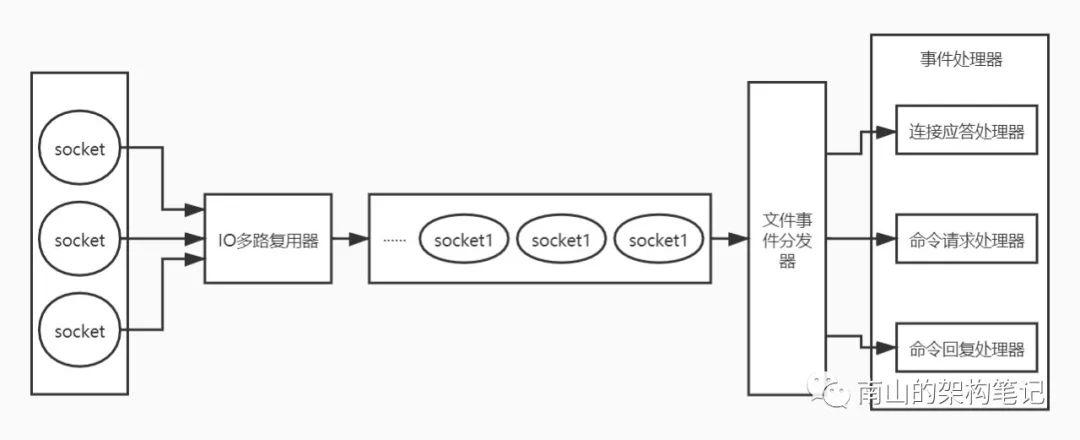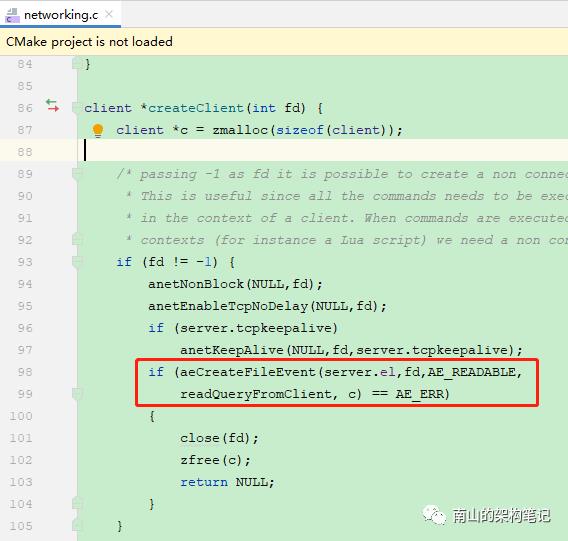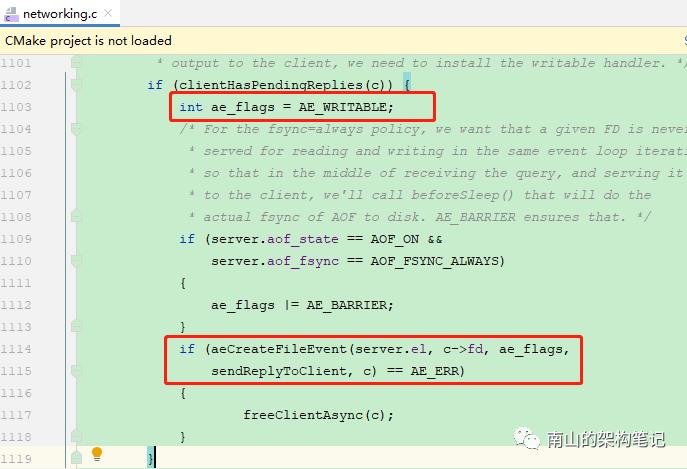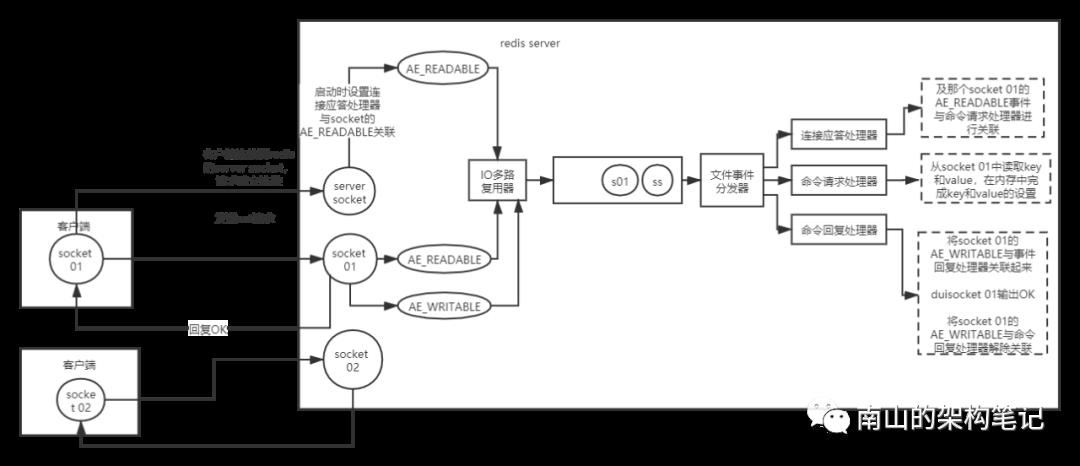面试题一文讲清,为啥redis单线程还有很高的性能?
Posted Hollis Chuang
tags:
篇首语:本文由小常识网(cha138.com)小编为大家整理,主要介绍了面试题一文讲清,为啥redis单线程还有很高的性能?相关的知识,希望对你有一定的参考价值。
面试的时候如果聊到缓存,肯定会聊到redis,因为它现在是缓存事实上的标准。
早些年一些互联网公司会用到memcached作为缓存,它是多线程的,用c语言开发,不过现在基本很少了,有兴趣的同学可以学习下它的源码。
那么聊redis,第一个问题就是它的工作原理,redis最最重要的工作原理,就是它的线程模型。
redis是单线程、nio、异步的线程模型,你要是这个都不知道,工作中用到redis,出了问题都不知道如何入手排查。
学习redis线程模型之前,必须了解socket网络编程相关知识,如果你不懂socket,肯定搞不懂redis原理。
redis使用文件事件处理器(file event handler)处理所有事件,这个文件事件处理器是单线程的,所以redis才叫单线程的。
文件事件处理器采用IO多路复用器,同时监听多个socket,将产生事件的socket放入内存队列中,事件分发器根据socket上的事件类型,选择对应的事件处理器进行处理。

图1 redis 文件事件处理器过程
文件事件处理器的结构包含 4 个部分:
客户端socket
IO 多路复用器
文件事件分派器
事件处理器(连接应答处理器、命令请求处理器、命令回复处理器)
多个客户端socket可能会并发产生不同的操作,每个操作对应不同的事件,但是 IO 多路复用器会监听多个socket,会将产生事件的 socket 放入队列中排队,事件分派器每次从队列中取出一个 socket,根据 socket 的事件类型交给对应的事件处理器进行处理。
连接应答处理器
在redis server启动的时候,会设置客户端建立连接时的连接应答处理器acceptTcpHandler,并和服务器监听套接字的AE_READABLE 事件关联起来,具体代码在server.c的initServer方法中:

图2 redis初始化设置连接应答处理器
在networking.c 文件中acceptTcpHandler方法实现中,redis的连接应答处理器,用于对连接服务器进行监听,对套接字的客户端进行应答相应。
#define MAX_ACCEPTS_PER_CALL 1000
void acceptTcpHandler(aeEventLoop *el, int fd, void *privdata, int mask) {
int cport, cfd, max = MAX_ACCEPTS_PER_CALL;
char cip[NET_IP_STR_LEN];
UNUSED(el);
UNUSED(mask);
UNUSED(privdata);
//循环处理连接应答
while(max--) {
cfd = anetTcpAccept(server.neterr, fd, cip, sizeof(cip), &cport);
if (cfd == ANET_ERR) {
if (errno != EWOULDBLOCK)
serverLog(LL_WARNING,
"Accepting client connection: %s", server.neterr);
return;
}
serverLog(LL_VERBOSE,"Accepted %s:%d", cip, cport);
acceptCommonHandler(connCreateAcceptedSocket(cfd),0,cip);
}
}连接应答处理器
在接收到客户端的连接后,触发链接应答处理器的acceptTcpHandler方法,这个方法里会创建客户端对于的client对象,它代表着连接到 Redis 客户端。并且accept客户端的连接,然后把这个连接与命令处理器readQueryFromClient关联起来,服务器会将连接成功后的socket的AE_READABLE事件和命令请求处理器关联起来,命令请求处理器就可以从socket中读取数据了。

图3 建立连接后设置命令请求处理器
通过 networking.c中的readQueryFromClient方法,读取客户端发送的命令内容。
void readQueryFromClient(aeEventLoop *el, int fd, void *privdata, int mask) {
client *c = (client*) privdata;
int nread, readlen;
size_t qblen;
UNUSED(el);
UNUSED(mask);
readlen = PROTO_IOBUF_LEN;
/* If this is a multi bulk request, and we are processing a bulk reply
* that is large enough, try to maximize the probability that the query
* buffer contains exactly the SDS string representing the object, even
* at the risk of requiring more read(2) calls. This way the function
* processMultiBulkBuffer() can avoid copying buffers to create the
* Redis Object representing the argument. */
if (c->reqtype == PROTO_REQ_MULTIBULK && c->multibulklen && c->bulklen != -1
&& c->bulklen >= PROTO_MBULK_BIG_ARG)
{
ssize_t remaining = (size_t)(c->bulklen+2)-sdslen(c->querybuf);
/* Note that the 'remaining' variable may be zero in some edge case,
* for example once we resume a blocked client after CLIENT PAUSE. */
if (remaining > 0 && remaining < readlen) readlen = remaining;
}
qblen = sdslen(c->querybuf);
if (c->querybuf_peak < qblen) c->querybuf_peak = qblen;
c->querybuf = sdsMakeRoomFor(c->querybuf, readlen);
nread = read(fd, c->querybuf+qblen, readlen);
if (nread == -1) {
if (errno == EAGAIN) {
return;
} else {
serverLog(LL_VERBOSE, "Reading from client: %s",strerror(errno));
freeClient(c);
return;
}
} else if (nread == 0) {
serverLog(LL_VERBOSE, "Client closed connection");
freeClient(c);
return;
} else if (c->flags & CLIENT_MASTER) {
/* Append the query buffer to the pending (not applied) buffer
* of the master. We'll use this buffer later in order to have a
* copy of the string applied by the last command executed. */
c->pending_querybuf = sdscatlen(c->pending_querybuf,
c->querybuf+qblen,nread);
}
sdsIncrLen(c->querybuf,nread);
c->lastinteraction = server.unixtime;
if (c->flags & CLIENT_MASTER) c->read_reploff += nread;
server.stat_net_input_bytes += nread;
if (sdslen(c->querybuf) > server.client_max_querybuf_len) {
sds ci = catClientInfoString(sdsempty(),c), bytes = sdsempty();
bytes = sdscatrepr(bytes,c->querybuf,64);
serverLog(LL_WARNING,"Closing client that reached max query buffer length: %s (qbuf initial bytes: %s)", ci, bytes);
sdsfree(ci);
sdsfree(bytes);
freeClient(c);
return;
}
/* Time to process the buffer. If the client is a master we need to
* compute the difference between the applied offset before and after
* processing the buffer, to understand how much of the replication stream
* was actually applied to the master state: this quantity, and its
* corresponding part of the replication stream, will be propagated to
* the sub-slaves and to the replication backlog. */
processInputBufferAndReplicate(c);
}
void processInputBufferAndReplicate(client *c) {
if (!(c->flags & CLIENT_MASTER)) {
processInputBuffer(c);
} else {
size_t prev_offset = c->reploff;
processInputBuffer(c);
size_t applied = c->reploff - prev_offset;
if (applied) {
replicationFeedSlavesFromMasterStream(server.slaves,
c->pending_querybuf, applied);
sdsrange(c->pending_querybuf,applied,-1);
}
}
}processInputBuffer主要是将输入缓冲区中的数据解析成对应的命令,根据命令类型是 PROTO_REQ_MULTIBULK 还是 PROTO_REQ_INLINE,来分别调用 processInlineBuffer 和 processMultibulkBuffer 方法来解析命令。
然后调用 processCommand 方法来执行命令,redis中有一个类似map的东西,会记录每条命令对应的handler,根据解析出来的命令执行对应的handler即可。
命令回复处理器
命令处理完之后,redis server就要给客户端返回处理结果。networking.c中的sendReplyToClient方法就是redis 的命令回复处理器,此时会将socket的AE_WRITEABLE事件和命令回复处理器关联起来。这个处理器负责将服务器执行命令后得到的命令回复先写到缓存,再通过套接字返回给客户端。

图4 设置命令回复处理器
最后画一幅完整的流程图,方便大家理解记忆。

图5 redis线程模型
有道无术,术可成;有术无道,止于术
欢迎大家关注Java之道公众号

好文章,我在看❤️
以上是关于面试题一文讲清,为啥redis单线程还有很高的性能?的主要内容,如果未能解决你的问题,请参考以下文章